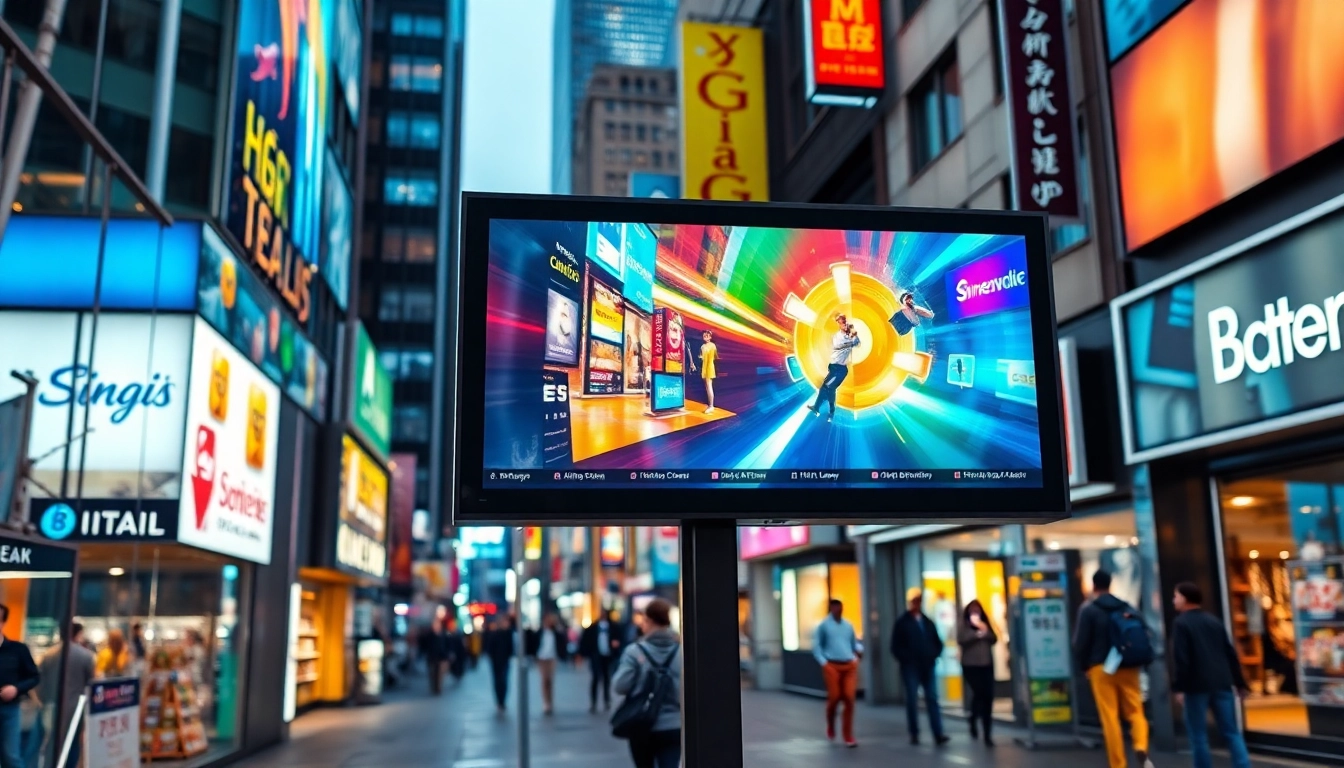Understanding Digital signage
What is Digital signage?
Digital signage is a dynamic form of advertising that leverages digital displays to present a variety of multimedia content, such as images, videos, and animations, to convey information and messages to audiences. This technology integrates various digital display technologies—including LED, LCD, and projection—to create visually appealing content that can be easily updated or changed, making it ideal for businesses looking to enhance communication and engagement with customers.
Companies are increasingly adopting Digital signage solutions as they offer greater flexibility and control over content presentation than traditional static signage. By utilizing screens in locations such as retail stores, corporate offices, transportation hubs, and hospitals, businesses can deliver real-time information, promotional material, or even instructions based on the immediate context or audience demographics. This adaptability allows for timely, relevant messaging aimed at maximizing viewer engagement.
Key Components of Digital signage
The effective implementation of digital signage requires understanding its key components, which include:
- Display Screens: These can vary from small tablet screens to large video walls or outdoor LED billboards, depending on the needs of the space and audience.
- Media Players: These devices manage playback of content on the display screens and can be standalone devices or built into the screens themselves.
- Content Management System (CMS): A software interface that allows users to create, schedule, and manage the content displayed on screens. It is the brain of digital signage, central to its operation.
- Content Creation Tools: Software and applications designed to help businesses design professional-quality content tailored to their audience.
- Network Infrastructure: A reliable network (wired or wireless) is necessary for delivering content updates and managing displays remotely.
Types of Digital signage Systems
Digital signage systems can be categorized based on their application and execution. Some common types include:
- Indoor Digital Signage: Typically found within buildings, such as shopping malls, airports, and offices, it aims to inform, entertain, or advertise.
- Outdoor Digital Signage: Specifically designed to endure weather conditions and is often employed in public areas for advertising or brand awareness.
- Menu Boards: Commonly used in restaurants and cafes, these screens display up-to-date information about available food items and prices.
- Wayfinding Displays: Digital maps or directional signs that help guide patrons through complex locations, enhancing user experience.
- Event Signage: Utilized at conferences or events to provide attendees with schedules, directions, and information.
Benefits of Digital signage for Businesses
Increased Engagement and Interaction
One of the primary benefits of Digital signage is its ability to significantly enhance audience engagement. Studies have demonstrated that consumers are more likely to engage with visual content than with text-based ads. Interactive displays, such as touch screens or QR codes linked to promotions or product information, encourage users to interact and retrieve information on their terms. This creates a more personalized experience that can lead to increased happy customers who may spend more time and money in a store.
Cost-Effectiveness Compared to Traditional Signage
Transitioning from traditional static signage to digital signage can lead to substantial savings and higher returns on investment (ROI). The ability to change messages quickly and without additional printing costs allows businesses to avoid common expenses associated with physical signage. Furthermore, digital signs can utilize a single screen to promote multiple products or services throughout the day, maximizing visibility and reducing the need for a larger physical footprint.
Enhanced Content Flexibility and Updates
The capability to instantly update and diversify displayed content is essential for modern organizations. With Digital signage, companies can alter their messaging based on targeted promotions, local events, or seasonal changes, ensuring information remains relevant and engaging. This adaptability not only maintains customer interest but also allows for real-time adaptability to unforeseen circumstances, such as supply shortages or emergencies.
Best Practices for Implementing Digital signage
Choosing the Right Location and Display
Determining the optimal location for digital signage is crucial to its success. High-traffic areas, such as store entrances, waiting rooms, or near elevators, can increase visibility and engagement. Additionally, the choice of display is vital; outdoor signs must be weather-resistant and bright enough to capture attention in daylight, whereas indoor displays can focus more on aesthetics and design.
Creating Compelling Visual Content
To engage audiences, businesses must invest time and creativity into creating compelling visual content. This includes using high-quality images, concise text, and dynamic animations that capture attention and encourage interaction. Consistent branding elements, such as logo and color schemes, should be employed to enhance brand recognition while ensuring messages remain concise to prevent overwhelming viewers.
Ensuring User-Friendly Navigation
Incorporating user-friendly navigation into digital displays enhances user experience and accessibility. This might include intuitive touch interfaces, clear instructions, and efficiently organized content. User feedback is invaluable; businesses should solicit input on the signage’s effectiveness and usability and utilize these insights for ongoing improvements.
Measuring the Effectiveness of Digital signage
Key Performance Indicators (KPIs)
Establishing effective measurement metrics is essential for assessing the impact of digital signage. Commonly used Key Performance Indicators (KPIs) include audience engagement rates (measured through interaction analytics), content view time, conversion rates related to promotions displayed on the signage, and foot traffic increases in areas where signage is installed. These can help in understanding how well the signage meets business objectives.
Gathering Audience Feedback
Implementing methods for gathering audience feedback about the signage can offer valuable insights. Surveys, interviews, or even social media integrations can be used to understand customer sentiment towards displayed messages. Feedback mechanisms are essential not only for improvements but to ensure the content resonates with target audiences.
Adapting Strategies Based on Analytics
Data-driven strategies should dictate content changes and display management. Analyzing collected data allows businesses to determine which messages are effective or which displays attract more attention. Regularly adapting content based on these analytics aids in continuous improvement, keeping the digital signage engaging and relevant.
Future Trends in Digital signage
Integration with Emerging Technologies
The future of Digital signage holds promising developments with the integration of emerging technologies such as artificial intelligence (AI) and augmented reality (AR). AI can enhance content personalization by analyzing audience behavior and preferences, ensuring relevant messages are delivered effectively. Meanwhile, AR applications may provide interactive experiences, such as enabling customers to visualize products in their environment through mobile devices, leading to enhanced engagement.
Personalization and Customer Targeting
This trend towards tailored messaging is likely to become increasingly sophisticated, with more businesses employing data analytics to deliver contextualized content to different segments of their audience. Strategies that leverage demographic data, behavioral patterns, and location will empower businesses to provide targeted experiences, increasing relevancy and improving engagement rates.
Sustainability and Eco-Friendly Practices
As sustainability becomes a growing priority for businesses and consumers alike, the digital signage industry is also leaning towards eco-friendly practices. Energy-efficient displays, sustainable materials in hardware, and content that promotes green initiatives are areas to watch. This commitment to sustainability not only appeals to environmentally-conscious consumers but can also enhance a brand’s public image and customer loyalty.















Leave a Reply